Island with a Tragic History.
Easter Island, 09.20.2016
Tuesday, Sept 20, 2016 We are back on central time. Very sleepy and dragging. We are greeted by a cheerful 20-something Gunther who picks us up from the airport, checks us into our room and gives us advice about grocery stores, renting a car, sites to see when here, and diving. BIG hibiscus greet us at our new home away from home. We walk to two of the dive shops and I sign up for a dive tomorrow at 9AM. Chick walks back to our place and I go in search of groceries. I found a small store which was able to use my credit card after 5 tries. Our usual South Pacific stew makings were available. I only get lost
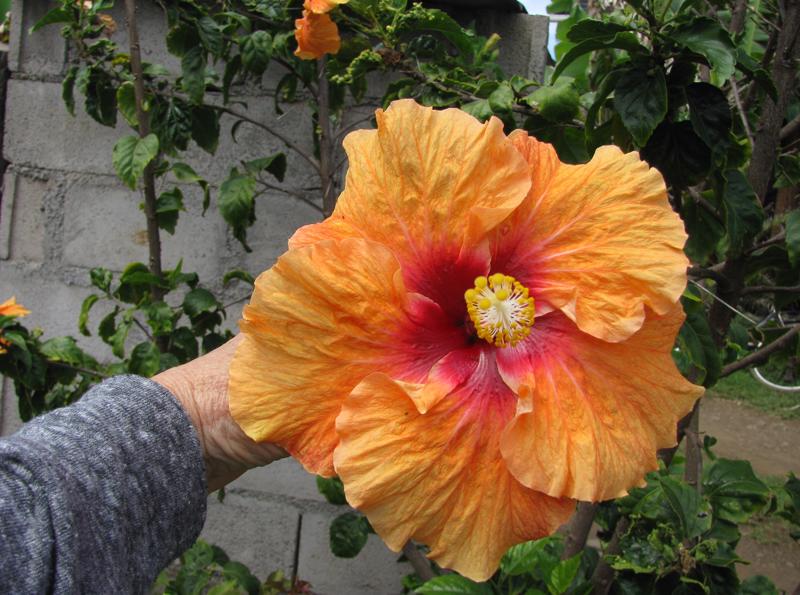
once on the return to the apartment. We are advised not to drink too much of the water due to many minerals. We are back in the land of 'don’t put paper in the toilet'. This is the southeastern point of the Polynesian triangle. Hawaii is the Northern point and New Zealand is the Western point.
photo #1 Biggest hibiscus I have ever seen grows outside our door.
photo #2 and #3 and #4 A variety of coral makes underwater landscapes pretty. Too many sea urchins suggest health decline of the environment.
photo #5 Moray eel
photo #6 Coral encrusted anchor.
photo #7 Modern Moai sunk for divers to enjoy.




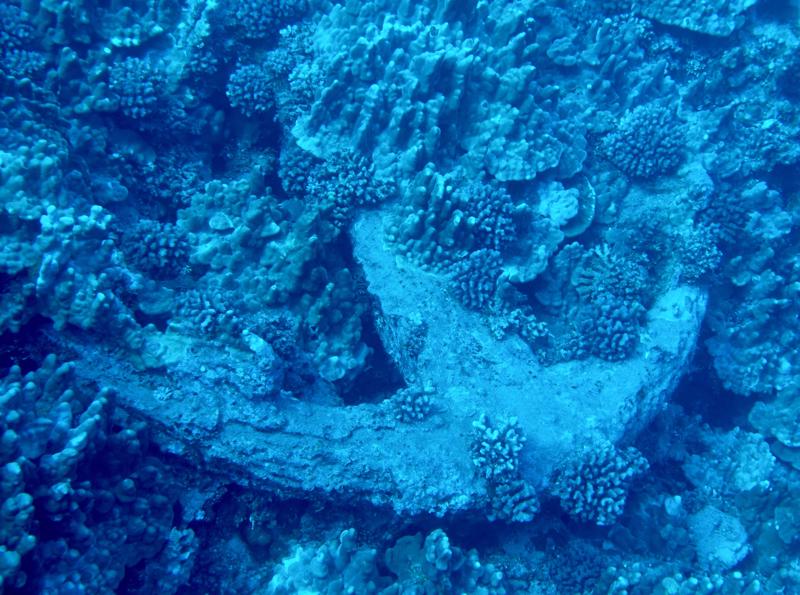
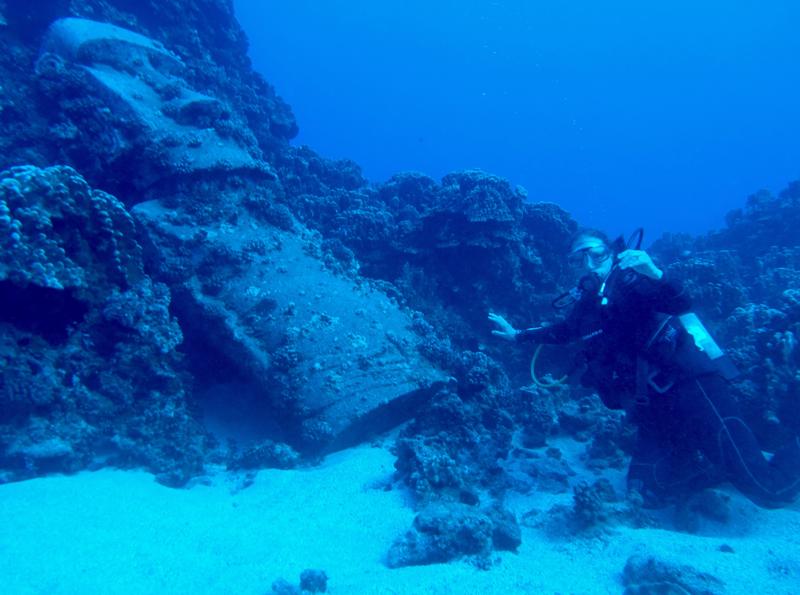
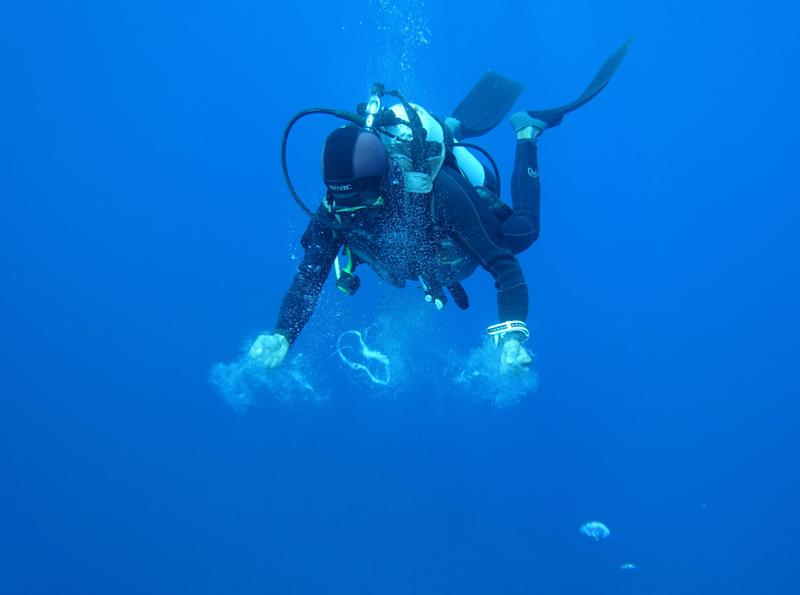
photo #8 Divemaster entertains us with bubble ring.
photo #9 View from the boat. Moai line the shore line.
photo #10 Moai faces dive shops. It was probably put there as a decoration for the shopping area. The row of boats are the ones used by the dive shops. No shade but the diving sites are very close to the harbor.
photo #11 This is an old moai that has weathered pretty badly. You can see bits of ears up close. It was probably the first one erected in the town area of the island. It sits about one hundred yards from our rented rooms. A nice surprise once we figured out what it was.
photo #12 Front view of five moai lining the shore seen from the dive boat in photo #8.
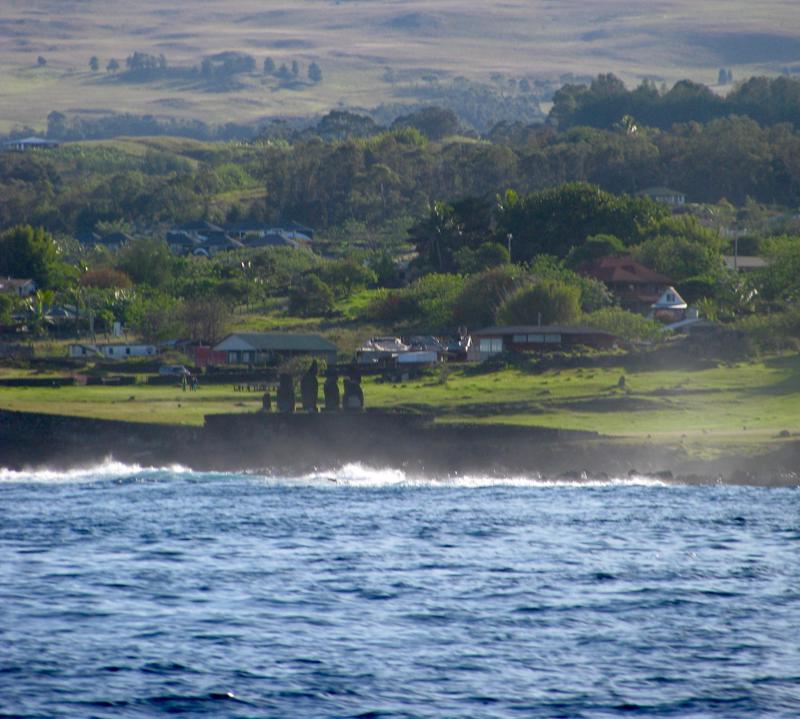
photo #13 Moa with restored eyes. When made and erected the last bit added is the eyes. Once they have eyes they become the guardians and watch over the village. Eyes are made with white coral around red stone or black obsidian pupils. This one also has it's hat or special hairdo. We are told that a popular hairstyle was a top knot. I think it is a hat. Only a small percentage of the moai have the 'hats'. All of the hats are made of the same red stone.
Wednesday Sept 21, 2016
Diving at the pyramid and the little islands sites. Coral is nicely shaped but not colorful. There are very few fish. No sharks, no turtles or other kinds of life that I see. There are two swim-through passages that we go through. One is a bit narrow and I bounce off the sides as the current helps me along. Water is cold, 20 degrees. Shower is warm. $60 US per dive. At the end of my second dive I feel like I have a bit of narcosis though I have not been down deep or long enough to justify that. I guess it is jet lag. We see a few Moai along the main road. Our place is in town which is about three blocks by 3 blocks.
Sept 22, 2016 Up again to dive at 9:00. This time we visit the underwater Moai that was placed there for divers. I see a leopard skin moray eel. When we get back to the dive shop a large turtle surfaces next to the boat. Glad to see that they are around. There are lots of surfers and snorkelers in the cold water. Some don’t wear wetsuits. Brrr.
Thursday September 22, 2016. Chick and I go for a walk along the shoreline. We go to the large park like area where many Moai are set up all looking in towards the land. They are surrounded by roped off areas that are clearly marked to prevent us from getting within about 30 meters of the Moai. There is a large boat launch area next to where the Moai are set up. It looks very modern and that it could

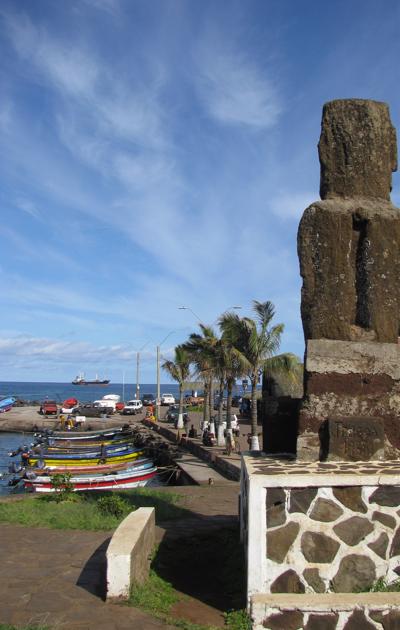
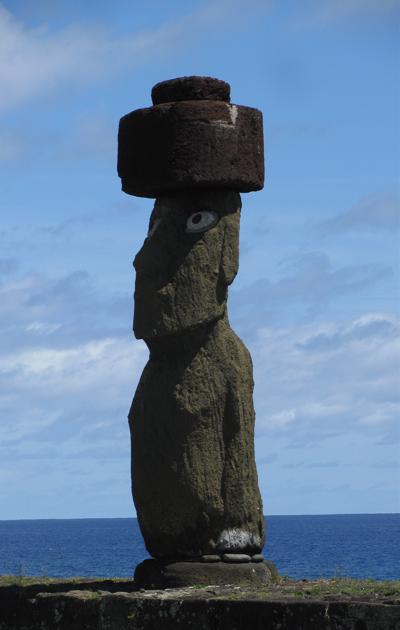
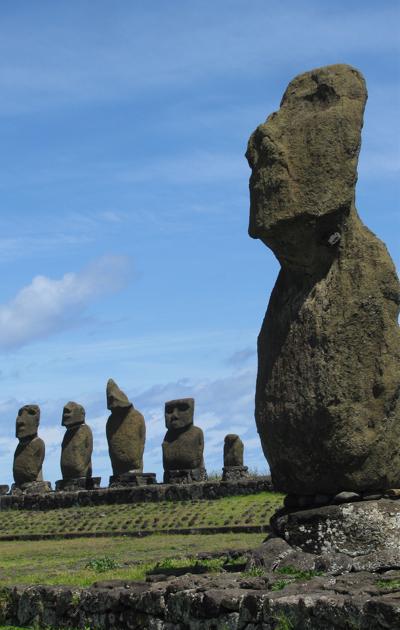
handle a good sized vessel. Later we find out that it is very old. It is well made. Off to one side of the row of Moai is a Moai that has been restored and has eyes and a hat. We were told that it is the only one that still has eyes. It is sad that this culture has been completely lost. The society collapsed and is gone with only the carved stone Moai to speak for them. Later we learn that this Moai is the only one who's eyes were found. The original eyes are in a museum and this Moai has reproductions. When all of the moais were being toppled during tribal wars, the eyes were pounded to powder to add further insult to the toppling. The warring tribes were insulting the moai and killing it by destroying the eyes.
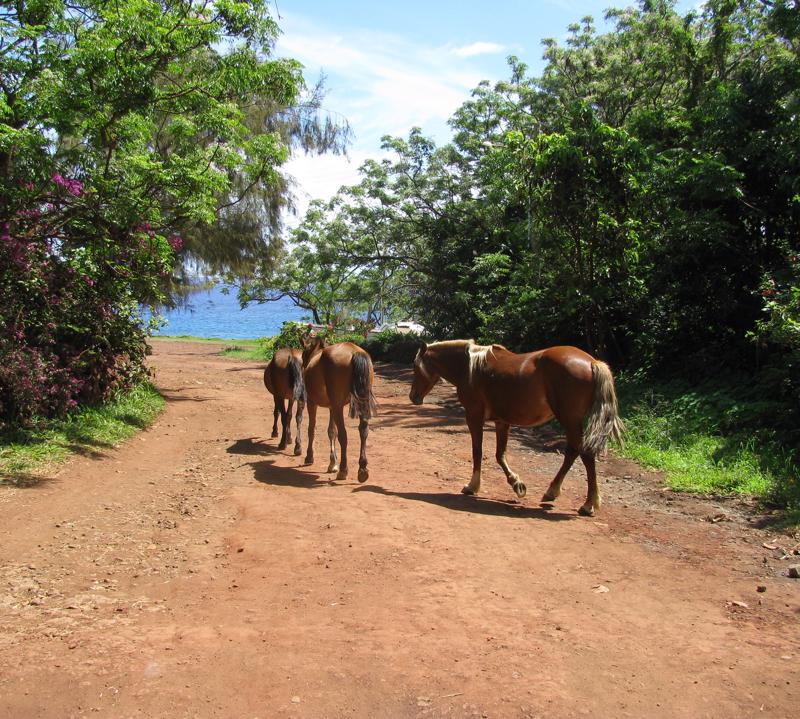
photo #14 On our walk we see horses wandering and eating grass. I stop to get a pebble out of my sock and one of the horses comes over and stands very close to me. I rub his foreleg where flies have been congregating. I notice his tail is not long enough to reach the area. It is broken off unevenly and only about 4 foot long. Later we will learn that the free ranging horses are all owned and we see brands on their right hip. We are told by our guide that the horses serve no function other than the ones that give tourist rides. We will see them all over the island. Many have colts with them. Our guide says they don't cost anything, they feed themselves and they are just kept as big pets. Sometimes they block the road and we have to go slowly through them. Dogs look in pretty good shape here. Most have no collar but they all seem well behaved around people. At night I sometimes hear a pack barking.
We walk to the bakery and grocery store. Tonight we have broccoli

and potato soup, rice and pinto beans with an oddly shaped large kiwi that is over ripe but superb. One of the best I have had. We also got some really good oranges. Tomorrow we will pack a lunch since we are going on an all day tour.
photo #15 I find that an umbrella is cooler than a hat. Here we stand in front of some of the 15 Moai on this platform.
photo #16 Just right of center, this is the largest Moai in the quarry. It is 21 meters tall. I wonder if they would have been able to move it had it been finished.
Saturday September 24, 2016 These last two days have been very good. I learned a lot about the history of Easter Island. Here is what I remember, augmented with help from wikipedia and other internet sources. There is a lot of uncertainty. Polynesians settled here between 400 AD or maybe as late as 1200 AD. They had a system of chiefs or kings that ruled each village. In the 1860s missionaries

recorded that there were nine chiefs and clans. There was much war and deforestation possibly influenced by the Polynesian rat which is known to alter vegetation of an ecosystem. The rats eat the seeds of trees. Building the stone Moai is thought to have started soon after the Polynesians settled here. Moai are cut from a stone cliff and were somehow transported in all 4 directions across the island. The stone figures with head and torso are made of a brittle soft volcanic tufa.
photo #17 Horses graze near abandoned Moai. These Moai were being transported down from the quarry. They have been partially buried by natural erosion as the hillside comes down around them.
photo #18 This is a lava bubble cave. It is rather large and the large caves like this one could have been used for ceremonies, to live in, or to bury people in. Smaller ones were used for sleeping and as chicken coops.
photo #19 I finally got a photo of a big splash. The coastline is very active. It is mesmerizing to watch the waves as they crash and travel
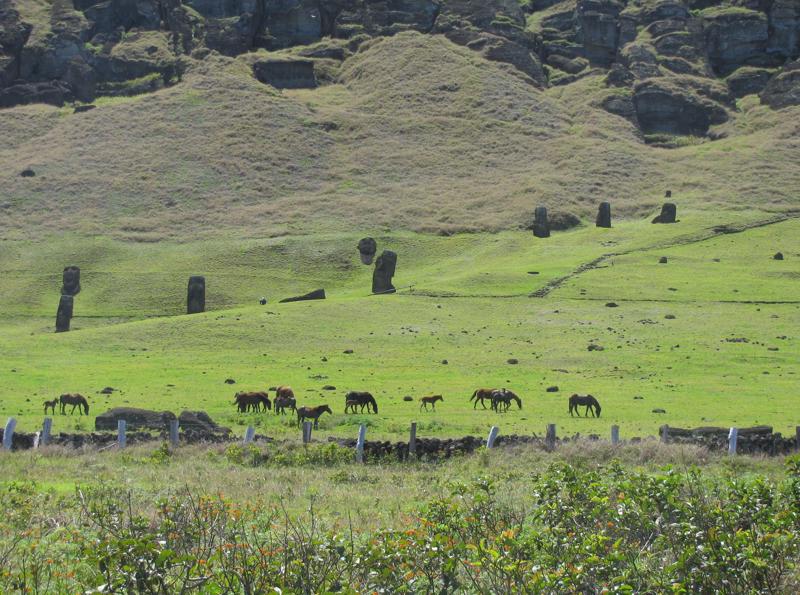
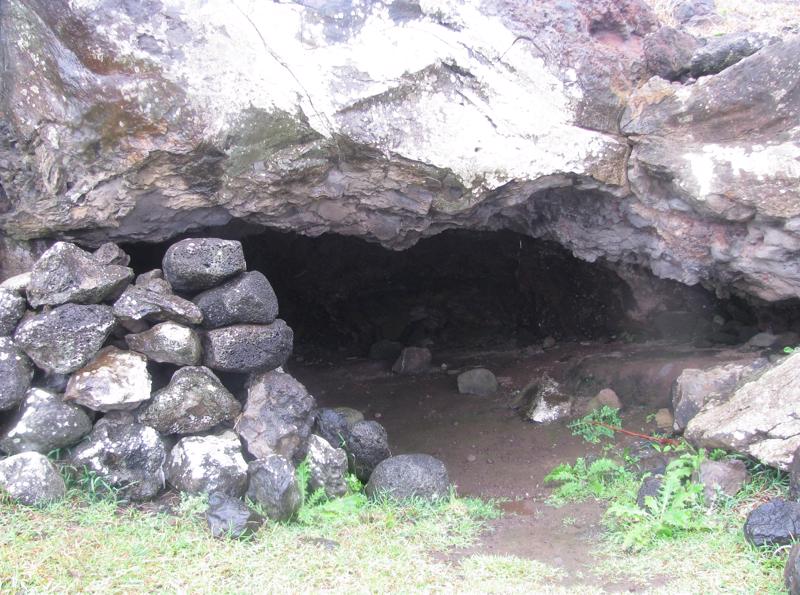
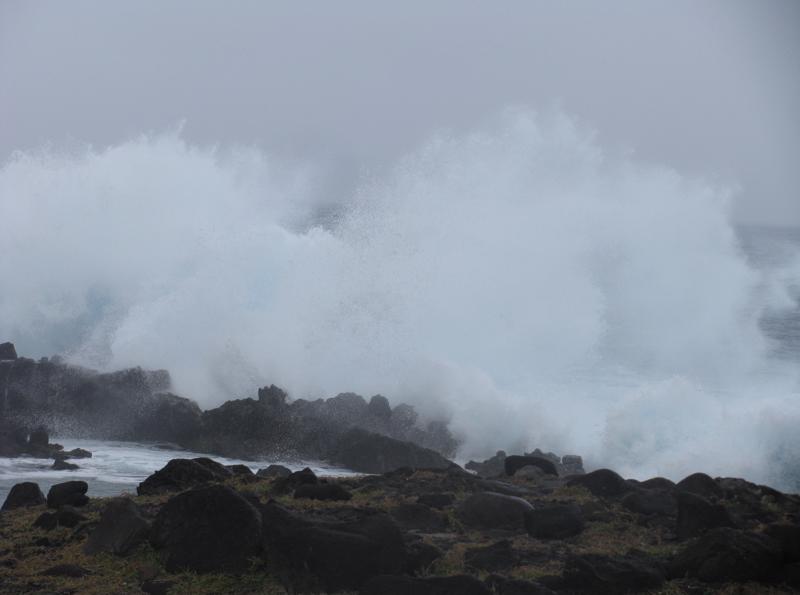
along hitting the shallows and finally the shore.
The stone Moai are made from is relatively lightweight but still weighs in the tons. How they transported it is unknown. The most popular method currently is that they walked them across the land by using ropes to pull them to one side and bring the lifted side forward then rocking it back to the other side. This seems do-able except the stone is soft and brittle and corners would be worn off during the process. Another theory is that they would be moved on rolling palm trees but the weight of some of them would probably crush any tree. As the years went on the chiefs who each had a Moai built to be the capstone of their grave each wanted a bigger and better Moai. One thousand Moai are on the island including about 400 that have been partially cut or still remain in the quarry. The earliest Moai were 2 to 3 meters high and the biggest in the quarry is 21 meters long weighing 270 tons. The biggest Moai standing is about 10 meters
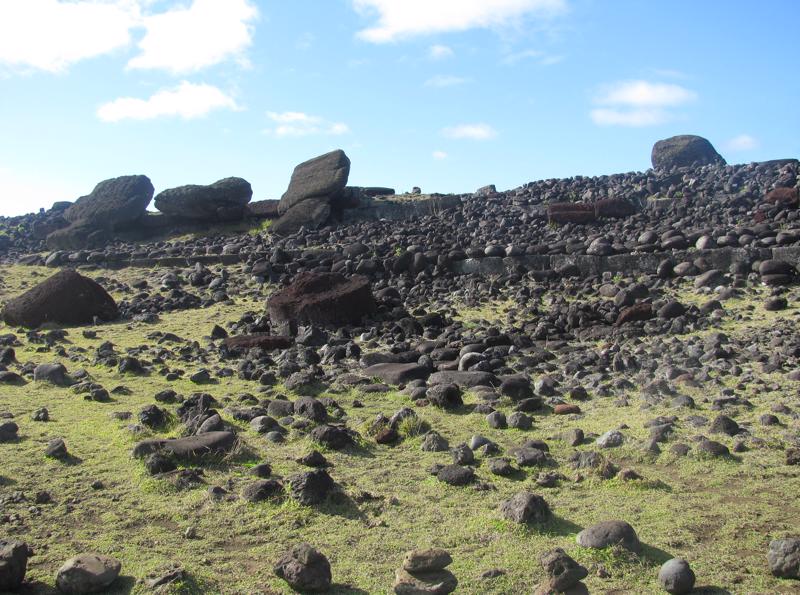
high. In the 1720s Europeans reported seeing standing Moai but by 1774 Captain Cook reported Moai toppled. By the 1830s only a few were still standing. It is thought that tribal war was the reason for the toppling. Eventually all of them were toppled. We can see where many broke when they landed. Most of them were pushed over to land on their faces. The moai all once stood facing villages on platforms. Some platforms are quite long and are used to bury the chief's ashes. I think the longest is more than 100 meters. It supports the 15 Moai that are shown in one of the photos. Platforms were often rebuilt as new Moai are added. Sometimes old moai were used to build the platforms. These would all have had their eyes removed and then just may be considered a piece of rock. The villages are near the sea and the Moai all face the villages which means they face inland to watch over the people. The most important people would live closest to the Moai with commoners living further from the sea. At some point the Moai were given hats made of dark red stone that is even softer and more brittle. They would start out very large at the quarry and be rolled to the Moai getting smaller with each kilometer. These hats or top knot hairdos would make the Moai taller and fancier. Once erected the moai would have had white coral eyes with either red stone or black onyx pupils. The Moai quarry is about 18 kilometers from the edges of the islands where they had to travel the farthest.
photo #20 This platform shows how they look before restoration. Moai are on their faces, some with broken necks, hats have rolled away, platforms have been raided for their stone to make walls.
In about 1540 a new system of governance was started called the Birdman cult. Moai building and transport stopped suddenly with partially completed Moai abandoned at the quarry and along the roads. The Birdman cult was all about a competition once a year. Each village or tribe would put forth a young athlete who along with much ceremony would swim out to the three little islands on the west side of the main island where I was diving a few days ago. There they would wait for a kind of Tern to migrate and lay eggs. The first athlete who was able to carry an egg back to the ritual site was the winner of a virgin bride and his chief became the Birdman and ruler of all of the tribes and control over distribution of the island's resources for his clan for the year. This maintained peace for a while. Eventually it is thought that the changing of ruler each year fostered some selfish and punitive behaviors which further depleted the environment and social order.
photo #21 Horses stand near the stone walls.
photo #22 Notice the fingers. All of the Maoi on the long platform have these fingers. It looks like a belt from a distance.
Slavery, European diseases and a still unknown problem of losing their trees all contributed to a plummeting population that took it from about 12,000 or 15,000 down to about 2000 by the time
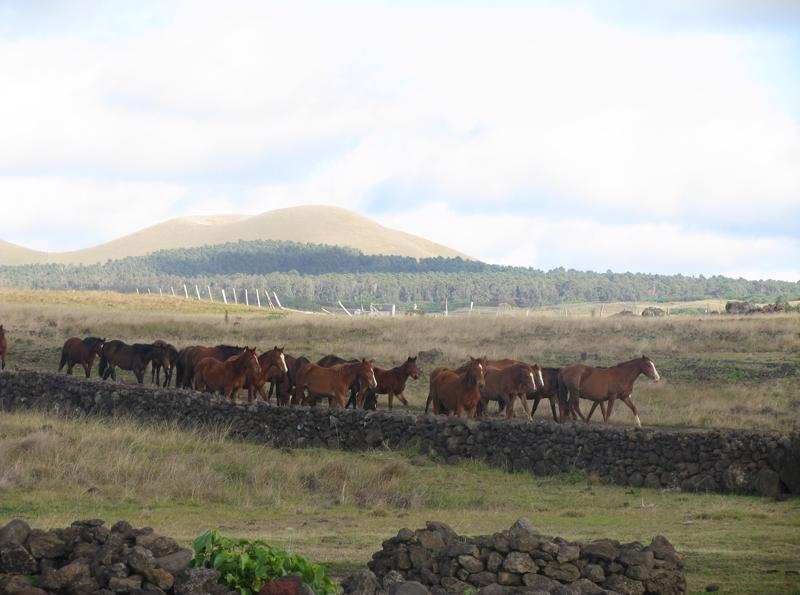

Europeans visited. 21 species of trees and all species of land birds became extinct through some combination of overharvesting/overhunting, rat predation, and climate change. They still have Polynesian chickens but bones from pigs which usually traveled with the Polynesians have not been found.
In the beginning of the 1860's 1500 able-bodied people from the island were captured to work as slaves, which would mean most of the men. Among the kidnapped was the ruling King. They were taken to work in guano mines off the coast of Peru. Population was further reduced when in 1867 some 2 to 15 ex-slaves were brought back home and brought smallpox with them. The other returning slaves died on the voyage home. They lost most of their oral history, the
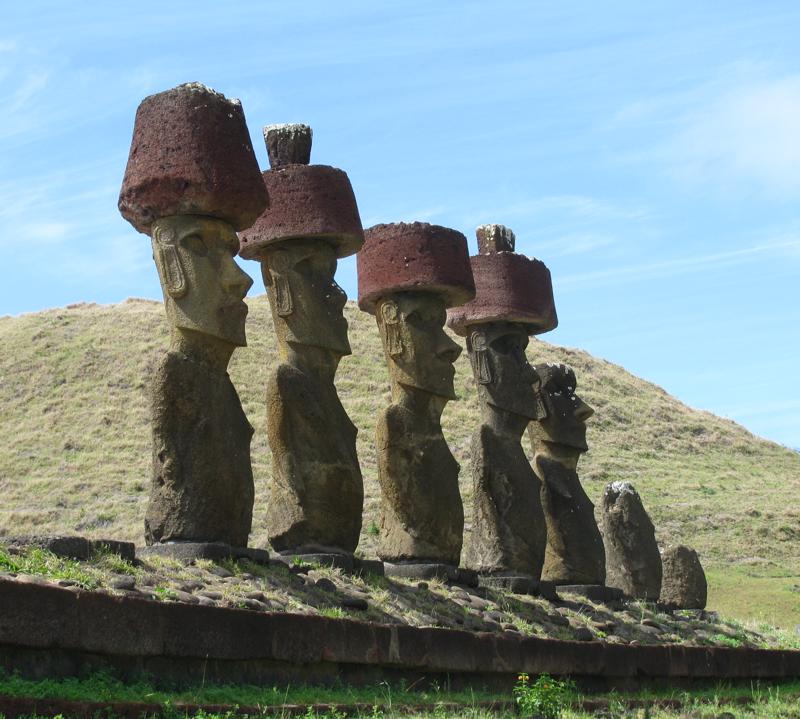
ability to read their glyphs, their leaders and their craftsmen.
photo #23 Moai with hats.
photo #24 Chick looks at hats. They could not be replaced on top of the Moai due to the damage of either the Moai or the hats. It is a delicate balancing act that the hats do up there.
In 1866 a Catholic mission was established. The missionaries told the natives to abandon their old practices, such as that of the Birdman competition and they did. They converted all natives to Christianity. No slave trade ever occurred at Easter Island again but the damage had been done. One of the missionaries brought Tuberculosis with him which also spread across the island and killed many in the same
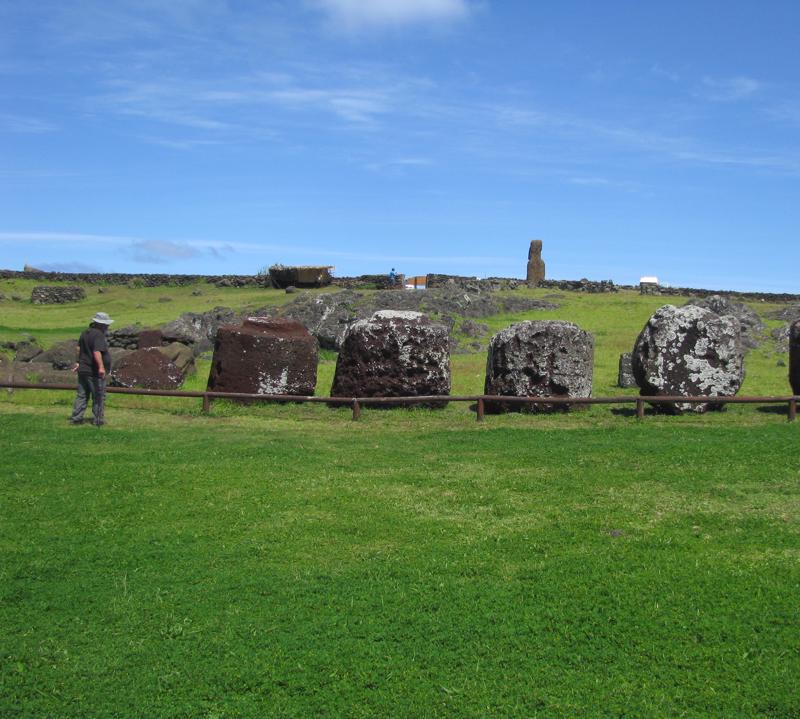
year, 1867, that smallpox was running through the island. This is when the population went down to 111. Starving sick people lived in stone houses or caves made by lava tubes or bubbles. We are told that people lived outside and only crawled into low ceiling shelters to sleep. These same kind of shelters, very low to the ground were also used to house chickens. We saw a few on our tours. They are truly just very low caves, lava bubbles with very small openings.
photo #25 Donna parades in front of the Moai.
photo #27 Petroglyph shows a tuna over a shark.
In 1903 Chile having taken possession of Easter Island leased out the whole island for raising sheep to the British/Chilean, Williamson

Balfour & Co. The Easter Island Exploitation Company signed a contract to lease the island as a sheep farm for 50 years. The island was divided with stone walls to separate the sheep. Guards kept the locals from going out of town. The people were forced to live in one area which is still the only area on the island with utilities. The population is about 5000 now. On our walk we met one man who was building a wall. He said about his work, "It is my culture to build walls with stones and no mortar." We see stone walls everywhere we go on the island. Many were built to contain the sheep. We see that the platforms which used to support the moai and act as burial places for the powerful people have been robbed of their stones and walls are nearby. It looks like the stones from the platforms were used to

make walls. In 1953 the lease of the island was not renewed. We have seen stone walls with no mortar on all of the islands we have visited on this trip through the Polynesian triangle.
Recently Chile is starting to let people own land but most of the island is owned by the Chilean government and most of the Moai are in the National Park. Some have been re-erected including 15 that a Japanese crane company helped to restore and at that time gave the island two cranes for that effort.
Sunday, September 25, 2016. We rented a car, drove around and we find some petroglyphs. We'll be leaving soon from the air strip that was remodeled by the USA for an alternate space shuttle landing site. We are going to Nuku Hiva which is probably where the Polynesians launched when they sailed to Easter Island.

Begin vandaag nog!
Waar wacht je nog op? Leg je avonturen vast in een digitaal dagboek dat je kan delen met vrienden en familie. Wissel op elk moment tussen verschillende apparaten. Ga aan de slag in onze online applicatie.
